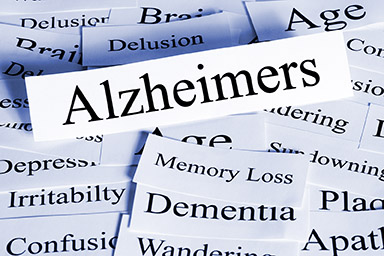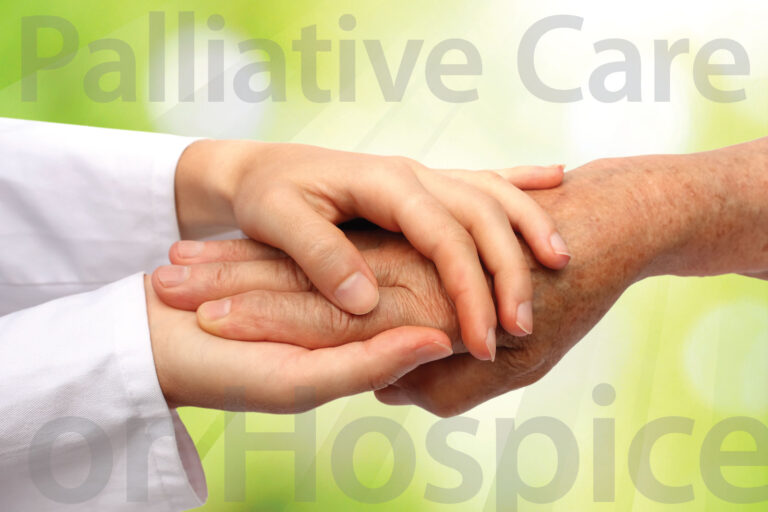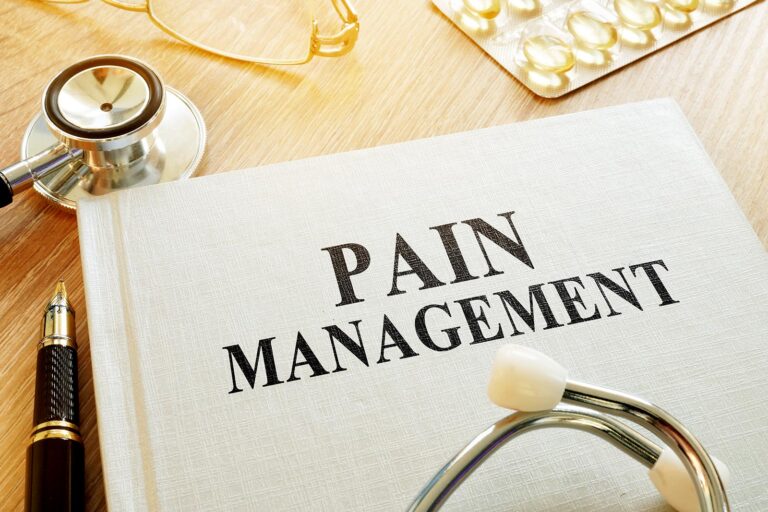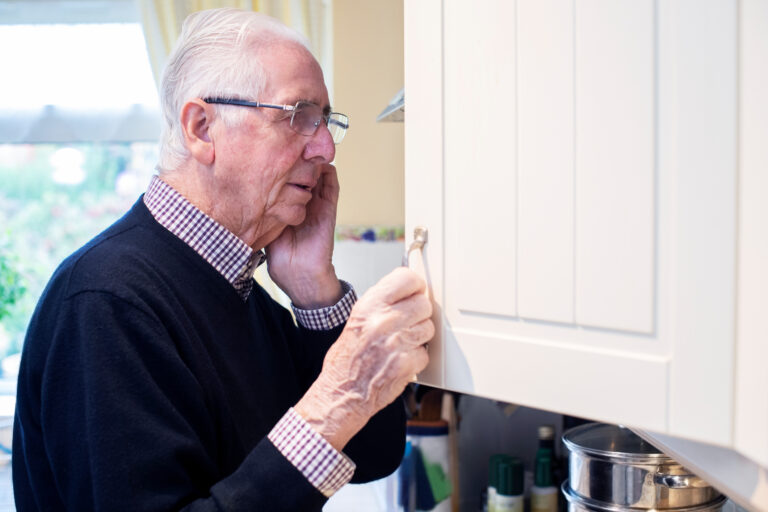What Are the Four Stages of COPD?
Chronic obstructive pulmonary disease, or COPD, can be a devastating diagnosis. It’s the third leading cause of death in the world, according to the World Health Organization (WHO). In the U.S., COPD affects one in every 8 adults aged 45 and older. This debilitating lung condition is most commonly seen in smokers, but many people who have COPD have never smoked cigarettes.
Marked by shortness of breath, wheezing, and chronic cough, COPD can greatly affect every aspect of a person’s life. There’s no cure for COPD, but it is preventable and treatable. Below, you’ll learn more about the stages of COPD, symptoms, and treatment, including how palliative and hospice care can help.
Are you or a loved one living with a chronic or terminal illness?
The Sage Family of Companies is here to help.
Are you or a loved one living with achronic or terminal illness?
The Sage Family of Companies is here to help.
What Is COPD?
COPD is a chronic lung disease in which the airways become inflamed, narrowed, or damaged. Symptoms include chronic cough, difficulty breathing, chest tightness, and frequent respiratory infections. COPD is most common among smokers. It’s a progressive disease with worsening symptoms over time.
Stages of COPD, Symptoms, and How Each is Treated
COPD is categorized by stage, with each one marked by progressively worsening symptoms. To diagnose COPD, your doctor will have you perform a spirometer test. This involves breathing into a machine that measures how hard and fast you’re able to exhale.
During the test, you’ll be scored on:
- Forced vital capacity (FVC), which is the quantity of air you can exhale.
- Forced expiratory volume in one second (FEV-1), or how much you can exhale in one second.
Your total score will be a ratio of FEV1/FVC. To receive a diagnosis of COPD, the ratio needs to be 0.7 or less. To determine what stage of COPD you have, your doctor will look at your FEV-1 score.
Here’s a closer look at the four stages of COPD, the symptoms of each, and how the condition is treated at different stages.
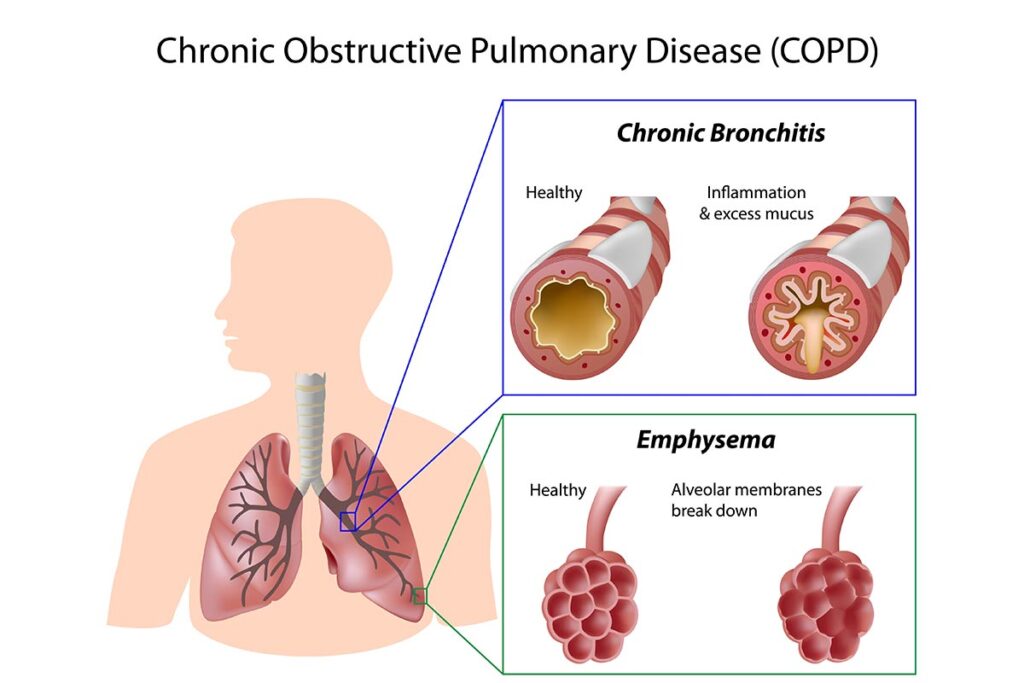
Stage 1 COPD: Mild
Stage 1 COPD is considered mild, with an FEV-1 of 80 percent or more. Symptoms may not appear at this stage, and many people with mild COPD may not even know they have the condition. If symptoms do develop, they may include shortness of breath and persistent cough.
Treatment for stage 1 COPD can vary from person to person but may include:
- Lifestyle changes, such as quitting smoking, avoiding second-hand smoke, eating a nutritious diet, and maintaining a healthy weight
- Medications to open up the lungs, such as bronchodilator medications, typically administered via an inhaler or nebulizer
- Getting vaccinated against pneumonia, influenza, and COVID-19, which can make respiratory symptoms worse and cause severe illness and even death
Stage 2 COPD: Moderate
Stage 2 COPD is moderate, with an FEV-1 of 50 to 80 percent. Symptoms typically show during stage 2 COPD or worsen if you had any symptoms during stage 1. They include shortness of breath while walking or exercising, persistent cough that may lead to mucus production, and tightness in the chest.
Treatments for stage 2 COPD include the treatments for stage 1, with the potential addition of inhaled corticosteroids or oxygen to increase air flow to the lungs.
Stage 3 COPD: Severe
Stage 3 COPD is severe, with an FEV-1 of 30 to 50 percent. At stage 3, symptoms are serious and can become debilitating. In addition to persistent coughing, shortness of breath, and chest tightness, you may also experience wheezing, difficulty breathing, swelling in the ankles, weight loss, and frequent respiratory infections. Daily activities and routine tasks may become more difficult, and you may have trouble leaving your home.
Treatments for stage 3 COPD are the same as the ones for stage 2, but the patient is more likely to need oxygen at this point.
Stage 4 COPD: Very Severe
Stage 4 COPD is also known as end-stage COPD. With an FEV-1 of less than 30 percent, end-stage COPD symptoms are very severe. You might have trouble breathing even while resting, and you may be completely home-bound. With stage 4 COPD, oxygen has difficulty reaching the blood. This puts you at risk of chronic respiratory failure and heart failure.
Treatment options for stage 4 COPD are the same as for other stages, but your doctor may recommend one of the following types of surgery:
- Lung transplant
- Bullectomy (a procedure to remove bullae, or large air spaces from the lungs, to improve air flow)
- Lung volume reduction surgery
Are you or a loved one living with a chronic or terminal illness?
The Sage Family of Companies is here to help.
Are you or a loved one living with achronic or terminal illness?
The Sage Family of Companies is here to help.
How Palliative Care Can Help
If you or a member of your family are living with COPD, you may want to consider palliative care. This is a specialized type of care that focuses on improving pain management, symptom relief, and enhancing quality of life for people living with chronic and life-limiting conditions.
Though they often get confused, palliative care isn’t end-of-life care. During palliative care, you’ll continue to receive treatments meant to stop the progression of your COPD. Palliative treatment, which can include symptom management, mental health counseling, alternative therapies like massage and Reiki, and spiritual guidance, is given alongside your regular care.
Anyone can receive palliative care at any age and at any stage of disease. Doctors often recommend palliative care at the time of diagnosis.
When It’s Time to Consider Hospice
If you or your loved one are no longer responding to treatments, or the burden of managing COPD has become too detrimental to your quality of life, it may be time to consider hospice care. Unlike palliative care, hospice is end-of-life care. It’s for people whose doctor estimates they have six months or less to live if their disease takes its natural course.
Hospice care focuses on maximizing comfort during the final days, weeks, and months of life. When you begin hospice care, your doctors stop treatments intended to stop the progression of your COPD. At this time, care transitions to the preparation for the end of your life. This can be an extremely emotional time, and your care team is specially trained to provide the needed support for you and your family. You can receive hospice care at home or at a hospice facility.
Can You Prevent Stage 4 COPD?
While there is no cure for COPD, that doesn’t mean there’s nothing you can do to prevent further damage to your lungs. A number of lifestyle changes can help slow the progression of COPD, including:
- Quitting smoking and avoiding second-hand smoke
- Getting vaccinated against respiratory diseases, including influenza, pneumonia, and COVID-19
- Adhering to your COPD treatment plan, including taking medications as directed
- Maintaining a healthy weight
- Exercising as tolerated (talk to your doctor about how you can safely exercise)
- Joining a pulmonary rehabilitation program where you can learn more about your COPD, as well as receive nutritional guidance, learn breathing techniques, and get exercise tips
Stages of COPD FAQ
Here are some frequently asked questions about the stages of COPD.
What is the Life Expectancy of Someone With COPD?
It’s impossible to predict how long a person will live with COPD. Various factors affect life expectancy, including age, the stage COPD you have, and your overall health and lifestyle habits, including whether or not you smoke cigarettes. For example, research shows that men aged 65 or older who currently smoke will experience, on average, a reduction in life expectancy of 5.8 years if they have stage 3 or 4 COPD.
Former smokers will experience a reduction of 5.6 years of life, while never-smokers will lose 1.3 years at these stages.
Is Stage 4 COPD Terminal?
Stage 4 COPD is often called end-stage COPD. It’s the most severe stage of disease and it comes with a higher risk of death. However, it’s possible to live many years with stage 4 COPD, with the right support and treatment plan.
At What Stage of COPD Do You Need Oxygen?
Typically, stage 4 COPD requires supplemental oxygen, though some people may need this treatment during stage 3 or even stage 2 COPD.
Summary
COPD is a debilitating chronic disease that can have a major impact on your family’s day-to-day life. While COPD is incurable, there are a number of steps you can take to prevent its progression, including stopping cigarette smoking. Palliative care can also help improve your quality of life at any stage of COPD. And if the time comes that your COPD becomes terminal, hospice care can step in to help assure you’re as comfortable as possible during the final days, weeks, and months of life.
The Sage Family of Companies is here to answer any questions you may have.
Article Resources
- Chronic obstructive pulmonary disease (COPD), WHO, 2024
- COPD National Action Plan, NIH, 2021
- Chronic Obstructive Pulmonary Disease, NIH, 2023
- Life expectancy and years of life lost in chronic obstructive pulmonary disease: Findings from the NHANES III Follow-up Study, International Journal of COPD, 2009



